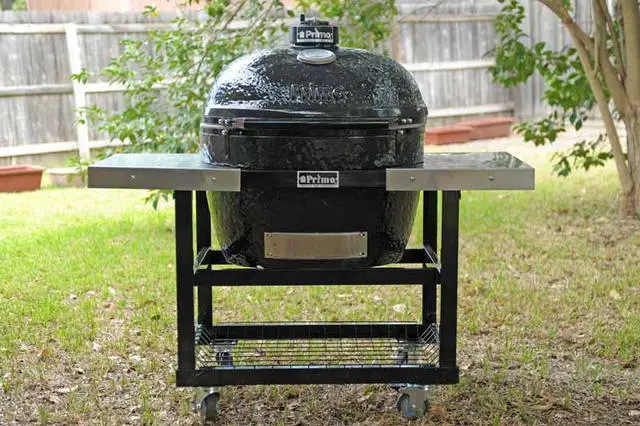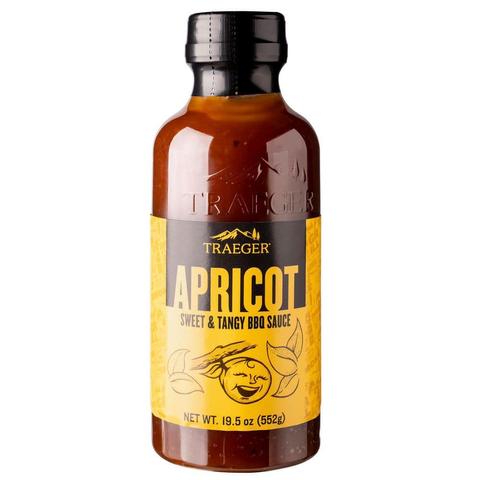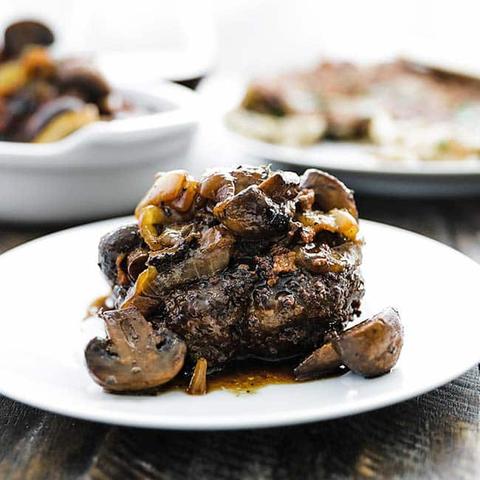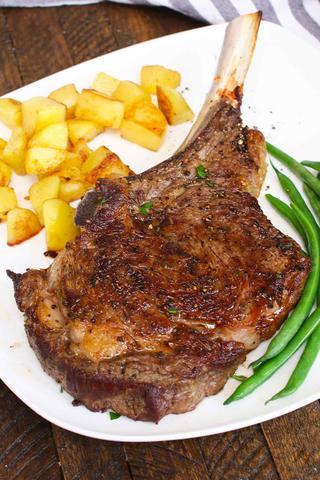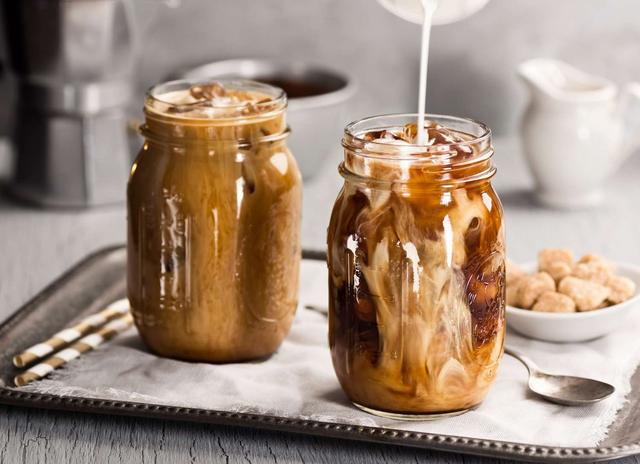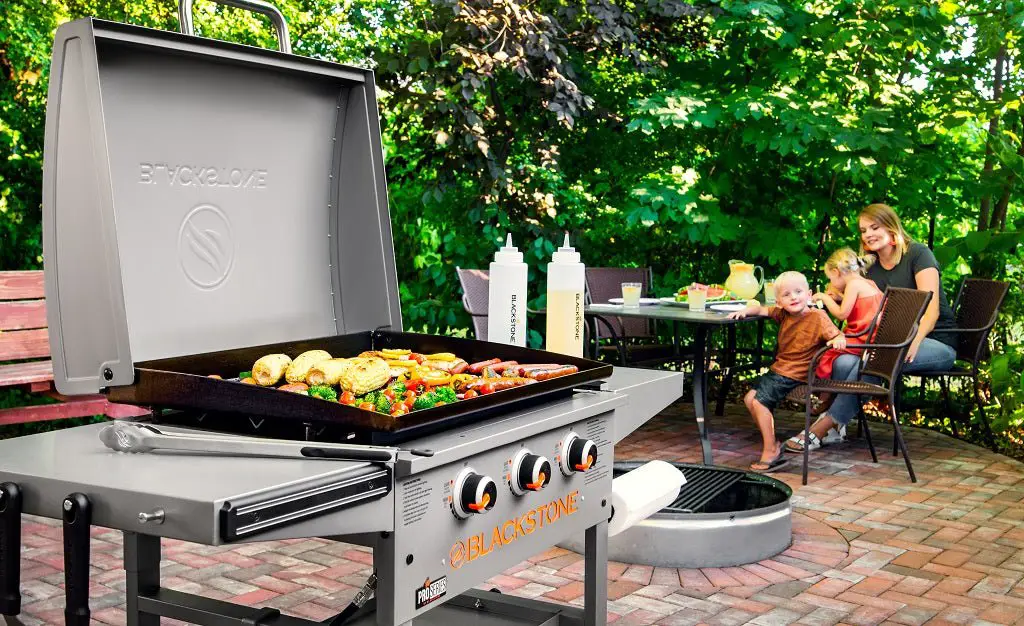
Discover the perfect cooking times for tender and juicy brisket with our comprehensive oven temperature chart. Master the art of slow roasting this flavorful cut, as we provide you with precise temperatures and time guidelines to achieve mouthwatering results every time.
HOW LONG TO SMOKE BRISKET IN OVEN AT DIFFERENT TEMP?: AN OVERVIEW CHART!
When smoking brisket in the oven at different temperatures, it is important to have an understanding of the timing involved. Smoking at a low temperature, such as 225°F, can take 1.5-2 hours per pound of meat. This slow cooking method allows for the connective tissues to break down and results in a tender and flavorful brisket.
If you prefer a slightly faster cooking time, you can increase the temperature to 250°F. At this temperature, it will take approximately 1-1.5 hours per pound of meat to smoke the brisket in the oven.

For those looking for an even quicker approach, the “hot and fast” method can be used. This involves setting the oven to a higher temperature, such as 275°F or 300°F. At these temperatures, it will take between 30-45 minutes per pound of meat to smoke the brisket.
It is important to note that the overall cooking time can vary depending on the size of the brisket. A larger brisket will generally require more time to cook than a smaller one.
To ensure that your brisket is cooked properly, it is recommended to use a meat thermometer to monitor the internal temperature. The brisket should reach a minimum internal temperature of 190°F before it is removed from the oven and allowed to rest.
In summary, smoking a brisket in the oven at different temperatures can take anywhere from 1.5-2 hours per pound at 225°F, 1-1.5 hours per pound at 250°F, or 30-45 minutes per pound at higher temperatures like 275°F or 300°F.
AT 225°F:
Slow smoking a brisket at a low temperature of 225°F has its benefits. It takes about 1.5 to 2 hours per pound of meat to prepare slow-smoked brisket. This method allows the meat fibers to relax and the gelatin in the brisket to melt, resulting in added flavor and moisture. Cooking at higher temperatures can cause the meat to become tougher due to tissue contraction and liquid release.
Cooking brisket at 250°F will result in a stronger, smokier flavor but may lead to a slightly drier texture. It requires around 1 to 1.5 hours per pound of meat.
At this temperature, the brisket slowly cooks, rendering the fat and resulting in flavorful and tender meat. It takes approximately 37.5 to 45 minutes per pound of meat.
The “hot and fast” method can be used for smoking brisket at this temperature range. It takes about 30 to 45 minutes per pound of meat, allowing for faster cooking while still achieving tender results.
It’s important to consistently monitor the internal temperature using a thermometer regardless of the chosen smoking temperature. A larger brisket will generally require more time to cook than a smaller one.

AT 250°F:
Slow smoking a brisket at 225 degrees allows for the connective tissue to break down, resulting in tender meat. It takes approximately 1.5-2 hours per pound of meat to smoke at this temperature. Cooking at a low and slow temperature also allows for added flavor and moisture as the gelatin in the brisket melts.
Cooking brisket at 250 degrees will result in a stronger, smokier flavor. However, it may also lead to a slightly drier texture. At this temperature, it takes approximately 1-1.5 hours per pound of meat to smoke the brisket.
Cooking brisket at 275 degrees is considered a moderate heat and allows for a relatively faster cooking time compared to lower temperatures. At this temperature, it takes approximately 37.5 to 45 minutes per pound of meat to smoke the brisket.
The “hot and fast” method involves cooking the brisket at higher temperatures between 275-300 degrees. While this method can result in faster cooking times (30-45 minutes per pound of meat), it is important to ensure that the internal temperature reaches a minimum of 190°F for tender results.
To smoke a brisket, start by trimming excess fat, seasoning the meat, and preheating the smoker to 225°F. Smoke the brisket for approximately 90 minutes per pound of meat until it reaches an internal temperature of around 160°F. Then wrap the brisket in foil or butcher paper and continue smoking until the internal temperature reaches at least 200°F. Allow the brisket to rest for at least 1 hour before slicing and serving.
To ensure a flavorful and tender brisket, avoid common mistakes such as selecting a brisket with good marbling, maintaining consistent cooking temperatures, resting the brisket after smoking, monitoring and adjusting the cooking temperature as needed, and choosing a complementary rub.
The hot and fast method can result in smoking a brisket in as little as 5 hours. However, it is important to note that brisket is a tough cut of meat that requires sufficient time to break down and become tender. Therefore, longer smoking times are generally recommended for optimal results.
After cooking a brisket, it is recommended to let it rest for at least one hour but no more than two hours. This allows the juices in the meat to redistribute, enhancing its flavor and tenderness.
AT 275°F:
At a temperature of 275°F, the brisket slowly cooks, rendering the fat and resulting in flavorful and tender meat. This moderate heat allows for a relatively faster cooking time compared to lower temperatures. For every pound of meat, it will require approximately 37.5 to 45 minutes at this temperature.
The “hot and fast” method is a faster approach to smoking brisket. By cooking at higher temperatures, typically between 275°F and 300°F, you can still achieve tender results while significantly reducing the cooking time. For each pound of meat, it will take approximately 30 to 45 minutes to prepare using this method. It is important to ensure that the internal temperature reaches a minimum of 190°F for safe consumption.
To ensure a flavorful and tender brisket, there are some common mistakes that should be avoided. These include selecting a brisket with good marbling and a thick flat for tenderness, trimming excess fat before smoking, maintaining consistent cooking temperature throughout the process, allowing the brisket to rest after smoking for at least an hour to redistribute juices, monitoring and adjusting cooking temperature as needed, choosing a complementary rub for flavor balance, and trimming excess fat to prevent greasiness.
The total cooking time for smoking a brisket can range between 12-18 hours depending on various factors such as size of the brisket, type of smoker used, and desired internal temperature. For best results, slow smoking at low temperatures around 225°F is recommended. At this temperature range, it takes approximately 1.5-2 hours per pound of meat. Smoking at higher temperatures may result in a slightly drier texture, but can be done at 250°F for 1-1.5 hours per pound or at 275°F for 37.5-45 minutes per pound. The “hot and fast” method can be used at temperatures between 275°F and 300°F, with a cooking time of 30-45 minutes per pound.
After smoking the brisket, it is important to allow it to rest for at least one hour but no more than two hours. During this resting period, the brisket’s juices redistribute, resulting in enhanced flavor and tenderness.
The recommended internal temperature for a well-cooked brisket is typically between 200-210°F (93-99°C). However, it is important to note that the actual cooking time may vary based on the thickness of the brisket. To ensure accuracy, it is crucial to monitor the internal temperature using a meat thermometer.
AT 300°F:
When smoking a brisket at 225°F, it will take approximately 1.5-2 hours per pound of meat. This slow cooking method allows the connective tissues to break down and results in a tender and flavorful brisket.
If you choose to smoke your brisket at 250°F, it will require around 1-1.5 hours per pound of meat. Cooking at this temperature can result in a slightly drier texture compared to lower temperatures, but it will also give the brisket a stronger, smokier flavor.
At a temperature of 275°F, the smoking time for a brisket is approximately 37.5 to 45 minutes per pound of meat. This moderate heat allows for faster cooking while still rendering the fat and producing tender and flavorful meat.
For those who prefer the “hot and fast” method, cooking a brisket at 300°F will take about 30 to 45 minutes per pound of meat. It is important to ensure that the internal temperature reaches at least 190°F for safe consumption.
Overall, the timing and temperature for smoking a brisket depend on factors such as size, smoker type, and desired doneness. It is crucial to monitor the internal temperature using a thermometer and allow for proper resting time after smoking to achieve optimal tenderness and flavor in your brisket.
WHAT ARE THE PHASES OF SMOKING A BRISKET AND TIME NEEDED
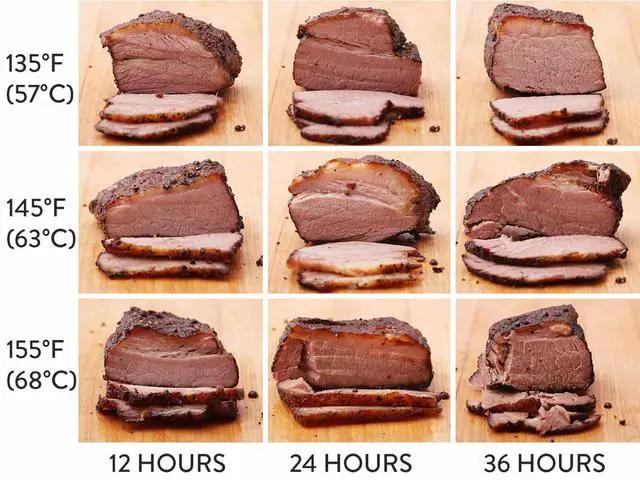
Smoking a brisket involves several phases, each requiring a specific amount of time:
1. Preparation: Begin by trimming excess fat, seasoning the brisket, and potentially injecting it with a brine or marinade. This step can take anywhere from 10 to 30 minutes.
2. Smoking: Preheat the smoker to 225°F and allow the brisket to smoke for approximately 90 minutes per pound of meat. For example, a 10-pound brisket would take around 15 hours to smoke. This phase requires patience as it is important to maintain a consistent temperature and monitor the internal temperature of the meat.
3. The Stall: Once the internal temperature reaches around 160°F, wrap the brisket in foil or butcher paper to retain moisture. This phase, known as “the stall,” can take anywhere from 2 to 5 hours. During this time, the connective tissues in the brisket break down, resulting in tender meat.
4. Final Cooking: Continue smoking the brisket until the thermometer reads at least 200°F. This stage generally requires an additional 4 to 6 hours, depending on the size of the brisket.
5. Resting: Allocate at least 1 hour for the brisket to rest after smoking. This allows the juices within the meat to redistribute, resulting in enhanced flavor and tenderness.
To ensure a successful smoked brisket, it is important to avoid these common mistakes:
1. Choosing a poor cut of meat: Select a brisket with good marbling and a thick flat to ensure tenderness.
2. Improper seasoning: Trim excess fat, season with a dry rub, and let the brisket sit at room temperature before smoking to allow the flavors to penetrate the meat.
3. Inconsistent temperature: Maintain a consistent temperature throughout the smoking process to ensure even cooking. Fluctuations can result in unevenly cooked meat.
4. Insufficient resting time: Allow the brisket to rest for at least an hour after smoking to let the juices redistribute, resulting in enhanced flavor and tenderness.
5. Neglecting temperature monitoring: Monitor and adjust the cooking temperature as needed for a perfectly cooked brisket. Using a meat thermometer is crucial for accurate readings.
The shortest time you can smoke a brisket will depend on various factors such as size, cooking temperature, and desired tenderness. However, using a hot and fast method, it is possible to smoke a brisket in as little as 5 hours. This method involves cooking at higher temperatures (typically between 275°F and 300°F) while still achieving tender results. It is important to monitor the internal temperature of the brisket and ensure it reaches at least 190°F for safe consumption.
1. PREPARING THE BRISKET
Before smoking a brisket, it is important to prepare it properly. Start by trimming excess fat from the brisket and seasoning it with a dry rub. Choose a brisket with good marbling and a thick flat to ensure tenderness. Let the seasoned brisket sit at room temperature for some time before smoking.
Preheat the smoker to the desired temperature based on the smoking method you choose. For slow smoking, set the temperature to 225°F, while for hot and fast method, set it to 275°F or higher. Place the seasoned brisket in the smoker and allow it to smoke for the recommended time per pound of meat.
Once the internal temperature of the brisket reaches around 160°F, wrap it in foil or butcher paper to retain moisture. This phase, known as the stall, can take several hours. Continue smoking until the thermometer reads at least 200°F.
After smoking, let the brisket rest for at least an hour but no more than two hours. This resting period allows the juices to redistribute throughout the meat, resulting in enhanced flavor and tenderness. Slice the rested brisket into portions and enjoy!
- Selecting a brisket with poor marbling or thin flat.
- Failing to trim excess fat before smoking.
- Inconsistent cooking temperature throughout the smoking process.
- Inadequate resting time after smoking.
- Using a rub that doesn’t complement the flavor of the meat.
- Leaving too much fat on the brisket, resulting in a greasy texture.
2. THE STALL
During the smoking process, you may encounter a phase known as “the stall.” This occurs when the internal temperature of the brisket plateaus and stops rising for several hours. The stall typically happens when the brisket reaches an internal temperature of around 160°F.
The stall can be frustrating for many smokers as it can make the cooking time longer than expected. However, it is an essential part of the smoking process. During the stall, moisture evaporates from the surface of the meat, which cools it down and slows down the cooking process.
To overcome the stall, you can wrap your brisket in foil or butcher paper once it reaches 160°F. This will help retain moisture and increase heat transfer, allowing your brisket to continue cooking more efficiently.
It’s important to note that every brisket is different, and the duration of the stall can vary. Some briskets may experience a shorter stall, while others may take longer. Patience is key during this phase, as rushing through it may result in a less tender and flavorful brisket.
By understanding and managing “the stall,” you can ensure that your brisket cooks evenly and becomes tender and delicious.
3. THE CONTINUED COOK:
After wrapping the brisket in foil or butcher paper during the stall phase, continue smoking until the internal temperature reaches at least 200°F (93°C). This stage typically requires an additional 4 to 6 hours of cooking time. It’s important to monitor the temperature throughout this phase to ensure that the brisket is cooked to the desired level of tenderness. The collagen and connective tissues in the brisket will continue to break down during this time, resulting in a more tender and flavorful meat.
Once the brisket has reached the desired temperature, it is crucial to let it rest for at least 1 hour before slicing. This resting period allows the juices to redistribute throughout the meat, resulting in a more moist and flavorful final product. You can choose to wrap the rested brisket in towels or place it in an insulated cooler to keep it warm until ready to serve.
It’s important to note that cooking times may vary depending on factors such as the size of the brisket and the type of smoker used. It’s always recommended to use a meat thermometer to accurately monitor the internal temperature of the brisket and adjust cooking times accordingly.
By following these steps and avoiding common mistakes, you can achieve a perfectly smoked brisket with tender and juicy results.
4. RESTING THE BRISKET:
After cooking a brisket, it is important to let it rest for at least one hour but no more than two hours. During this resting period, the brisket’s juices redistribute, allowing for enhanced flavor and tenderness. Resting also helps the meat retain its moisture and prevents it from drying out when sliced. To rest the brisket, simply remove it from the smoker or oven and place it on a cutting board or platter. Loosely tent it with aluminum foil to keep it warm. Avoid cutting into the brisket right away as this can cause the juices to escape, resulting in a drier end product. Instead, use this time to prepare any sides or sauces that will accompany the brisket. After resting, slice the brisket against the grain into portions of your desired thickness and serve immediately to enjoy its flavorful and tender smoked goodness.
5. SLICING AND SAVORING:
After the brisket has rested for at least one hour, it is time to slice and savor the delicious smoked meat. Start by cutting against the grain to ensure tenderness in each bite. The ideal thickness for slices is around ¼ inch. As you slice, you will notice a beautiful smoke ring surrounding the meat, indicating that it has been perfectly cooked. Serve the sliced brisket with your favorite barbecue sauce or enjoy it as is, reveling in the smoky flavor and juicy texture. Whether you’re hosting a backyard barbecue or simply indulging in a mouthwatering meal, take time to savor each bite of this delectable dish.
WHY DOES IT TAKE MUCH TIME TO SMOKE A BRISKET?
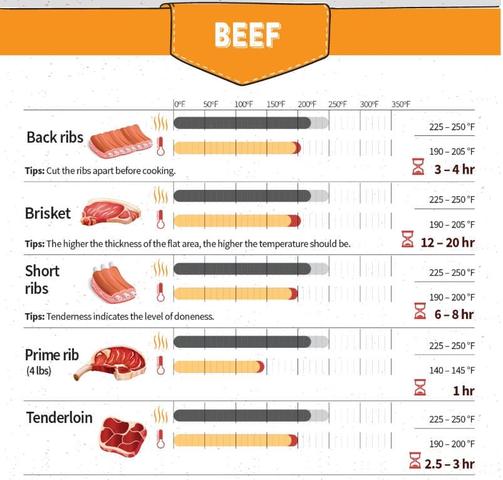
Smoking a brisket takes a significant amount of time due to the nature of the meat. Brisket is a tough cut with lots of connective tissue, which requires slow cooking at low temperatures to break down and become tender. The collagen in the meat needs time to melt into gelatin, resulting in added flavor and moisture. Additionally, smoking at higher temperatures can cause the meat to become even tougher and result in a less tender brisket. Therefore, it is necessary to smoke brisket at lower temperatures for a longer duration to achieve optimal tenderness and flavor.
SOME COMMON MISTAKES TO AVOID WHEN SMOKING A BRISKET
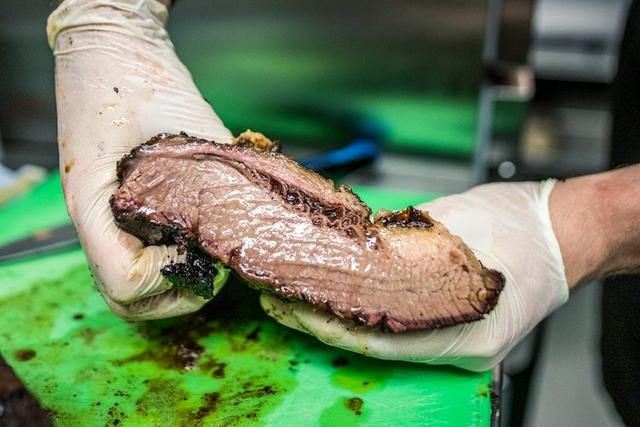
1. Selecting a brisket with poor marbling and a thin flat, which can result in a less tender final product.
2. Failing to trim excess fat before smoking, leading to a greasy and unappetizing brisket.
3. Not allowing the brisket to rest for at least an hour after smoking, which can result in dry meat.
4. Inconsistent temperature control throughout the smoking process, leading to uneven cooking.
5. Choosing a rub that doesn’t complement the flavor of the meat, resulting in a bland or overpowering taste.
6. Overcooking or undercooking the brisket by not monitoring and adjusting the cooking temperature as needed.
By avoiding these common mistakes, you can greatly increase your chances of achieving a flavorful, tender, and perfectly smoked brisket.
FREQUENTLY ASKED QUESTIONS (FAQS):
1. How long does it take to smoke a brisket at different temperatures?
The cooking time for smoking a brisket can vary depending on the temperature used. At 225°F, it can take approximately 1.5-2 hours per pound of meat. At 250°F, it can take around 1-1.5 hours per pound of meat. For the “hot and fast” method at 275°F, it can take 37.5 to 45 minutes per pound of meat.
2. What are the phases involved in smoking a brisket and how much time is needed for each phase?
The stages involved in smoking a brisket include trimming and seasoning the brisket, preheating the smoker and allowing the brisket to smoke (90 minutes per pound of meat), wrapping the brisket once it reaches an internal temperature of around 160°F (can take 2-5 hours), continuing to smoke until the thermometer reads at least 200°F (additional 4-6 hours), and resting the brisket for at least 1 hour.
3. What are some common mistakes to avoid when smoking a brisket?
Some common mistakes to avoid when smoking a brisket include not selecting a good quality brisket with marbling and a thick flat, not maintaining a consistent temperature throughout the cooking process, not allowing the brisket to rest after smoking, not monitoring and adjusting the cooking temperature as needed, choosing an inappropriate rub that doesn’t complement the flavor of the meat, and not trimming excess fat before smoking.
4. Does a brisket have to reach exactly 200 degrees Fahrenheit?
No, a well-cooked brisket typically falls within the range of 200-210°F. It is not necessary for the brisket to reach exactly 200 degrees Fahrenheit or any specific temperature.
5. How long can a brisket rest after cooking?
After cooking, it is recommended to let the brisket rest for at least one hour but no more than two hours. During this resting period, the brisket’s juices redistribute, enhancing its flavor and tenderness.
DOES BRISKET HAVE TO REACH 200 DEGREES?
Smoking a brisket at different temperatures will result in varying cooking times. Here is a comprehensive chart that outlines the recommended smoking temperatures and cooking times per pound of meat:
– 225°F: 1.5-2 hours
– 250°F: 1-1.5 hours
– 275°F: 37.5 to 45 minutes
– 300°F: 30 to 45 minutes
The total cooking time for smoking a brisket can range between 12 to 18 hours, depending on the size of the brisket.
Smoking a brisket involves several phases, each requiring a specific amount of time:
1. Preparing the Brisket: Trim excess fat, season the brisket, and potentially inject it with brine or marinade.
2. Slow Smoking: Smoke the brisket at a low temperature (225°F to 250°F) for approximately 90 minutes per pound of meat.
3. The Stall: Once the internal temperature reaches around 160°F, wrap the brisket in foil or butcher paper and continue smoking. This phase can take anywhere from 2 to 5 hours.
4. Final Cooking Stage: Continue smoking until the thermometer reads at least 200°F. This stage typically requires an additional 4 to 6 hours.
5. Resting Period: Allow the brisket to rest for at least one hour after smoking.
To ensure a flavorful and tender smoked brisket, it’s important to avoid these common mistakes:
1. Choosing The Wrong Brisket: Select a brisket with good marbling and a thick flat for tenderness.
2. Inconsistent Temperature: Maintain a consistent temperature throughout the smoking process for even cooking.
3. Insufficient Resting Time: Allow the brisket to rest for at least an hour after smoking to let the juices redistribute.
4. Not Monitoring Cooking Temperature: Regularly monitor and adjust the cooking temperature as needed for a perfectly cooked brisket.
5. Using An Unsuitable Rub: Choose a rub that complements the flavor of the meat to avoid a bland or overpowering taste.
While brisket is traditionally slow-smoked over a long period of time, it is possible to smoke it in as little as 5 hours using a hot and fast method. However, this method requires careful monitoring of the internal temperature to ensure that it reaches at least 190°F. It’s important to note that smoking a brisket at higher temperatures may result in slightly drier texture compared to slow smoking.
No, brisket does not have to reach exactly 200 degrees Fahrenheit (93 degrees Celsius) or any specific temperature. The recommended range for a well-cooked brisket is typically between 200-210°F (93-99°C). It’s crucial to monitor the internal temperature using a meat thermometer to determine when the brisket is done.
Yes, after cooking a brisket, it is recommended to let it rest for at least one hour but no more than two hours. During this resting period, the brisket’s juices redistribute, resulting in enhanced flavor and tenderness.
In conclusion, smoking a brisket requires proper timing and attention to detail. By following the recommended smoking temperatures and cooking times, avoiding common mistakes, and allowing the brisket to rest, you can achieve a flavorful and tender smoked brisket.
WHAT IS THE SHORTEST TIME YOU CAN SMOKE A BRISKET?
The shortest time you can smoke a brisket is around 5 hours using the hot and fast method. However, it’s important to note that smoking a brisket for a shorter duration may result in less tender meat compared to traditional slow-smoking methods. The longer cooking times at lower temperatures allow the connective tissue in the brisket to break down, resulting in a more tender and flavorful final product. So while it is possible to smoke a brisket in a shorter time frame, it is generally recommended to opt for slower cooking methods for optimal results.
CAN BRISKET REST FOR 2 HOURS?
After cooking a brisket, it is recommended to let it rest for at least one hour but no more than two hours. During this resting period, the brisket’s juices redistribute, resulting in enhanced flavor and tenderness. Resting allows the meat to relax and reabsorb its own moisture, making it juicier and more flavorful when sliced and served.
FINAL WORDS
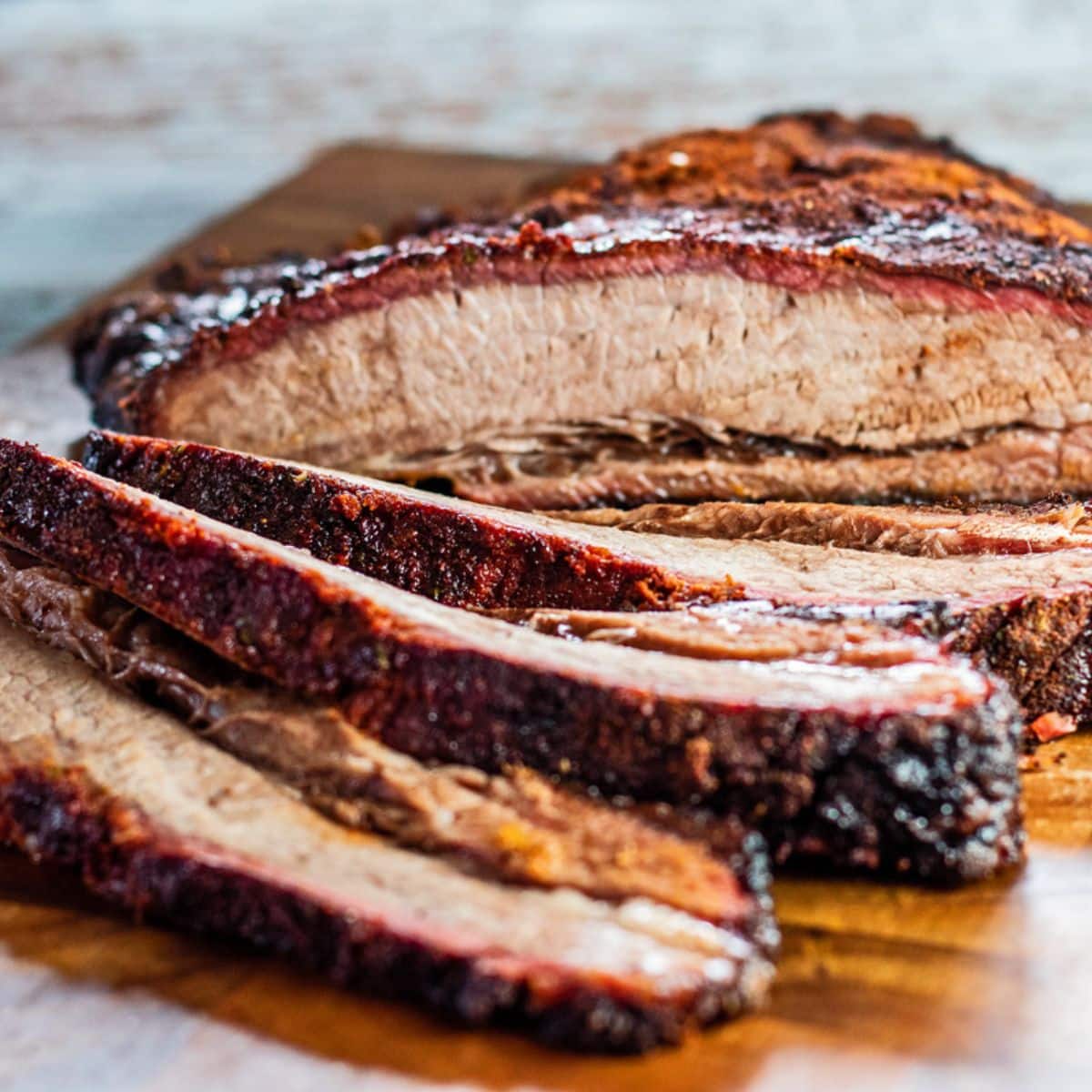
Smoking a brisket requires careful attention to timing and temperature. The recommended smoking temperatures and slow cooking times per pound of meat are 225°F (1.5-2 hours) and 250°F (1-1.5 hours). For a faster approach, you can set the temperature to 275°F (37.5 to 45 minutes) or 300°F (30 to 45 minutes). The entire process can take 12-18 hours depending on the size of the brisket.
Slow smoking at a low temperature allows for the connective tissue in the brisket to break down, resulting in a more tender and flavorful meat. Cooking at higher temperatures can cause tougher meat due to tissue contraction. It’s important to monitor the internal temperature with a thermometer to ensure it reaches at least 190°F for optimal tenderness.
There are different stages involved in smoking a brisket, including trimming excess fat, seasoning, smoking at low temperatures, wrapping in foil or butcher paper during the stall phase, and continuing smoking until reaching an internal temperature of around 200°F. After smoking, letting the brisket rest for at least one hour allows the juices to redistribute for enhanced flavor.
Some common mistakes to avoid when smoking a brisket include choosing a good quality cut with marbling, maintaining consistent temperature throughout cooking, allowing ample resting time, monitoring and adjusting cooking temperature as needed, and selecting a rub that complements the flavor of the meat.
While there is no specific temperature requirement for a well-cooked brisket, it is typically recommended to reach between 200-210°F. It is also possible to cook brisket in as little as five hours using a hot and fast method.
In conclusion, mastering the art of smoking brisket takes practice and patience. By following proper timing guidelines and avoiding common mistakes, you can achieve a flavorful and tender smoked brisket that will impress your guests.
In conclusion, using a brisket oven temperature chart is essential for achieving the perfect results when cooking brisket. It provides clear guidelines on the ideal temperatures and cooking times, ensuring a tender and flavorful outcome. By following the chart, you can confidently cook brisket to perfection every time.
Learn More About Grilling
If you want to learn more about grilling, check out these other helpful resources!

